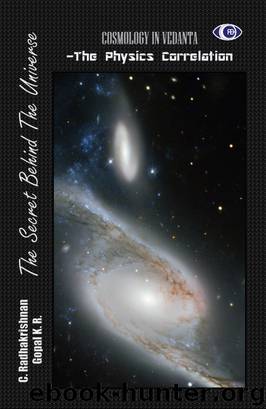Cosmology in Vedanta - The Physics Correlation by C. Radhakrishnan

Author:C. Radhakrishnan
Language: eng
Format: epub
Tags: karma, bhagavad gita, dark matter, upanishad, brahma, prakriti, atman, brahman, higgs, astrophyics
2.6 Possibilities in the far future
As the wave of expansion of avyakta crosses the expansion phase, universe would become ‘humble’, i.e., its toughness reaches unity and then goes below it. As it reaches the flat stage, gravitation ceases because the tendency of avyakta to expand would be present no more. As it goes humble, S would develop the tendency to shrink. The gravitational wave can start to repel – formation of the anti-gravity wave.
At the end of expansion phase, avyakta would have become infinitely humble; the particles would continue its stepwise decay (including proton decay) until it is dissolved in humbleness.
Once the contraction starts, the resultant turbulence would bring up the humble-in-humble particles from the infinitely humble core; the true antiparticles, instead of the tough-in-tough particles created during the Big Spiral Bang. There are no stars, no planets in this reverse phase, because gravitation repels; it is eternal night which ends as the contraction phase reaches culmination. The anti-particles decay and fade away as avyakta regains toughness, and the universe is cleaned-up for the next Spiral Bang, when everything is freshly created. On its own the universe renews its interior décor at every cycle of oscillation.
In a background of humble S, mirror images of both our particles and antiparticles are formed. The humble-in-humble antiparticle is different from the humble-in-tough antiparticle in that its content is even 'less' than our antiparticle. That means that the 'antiparticleness' here is applicable only to this phase of tough S; the real mirrors are even more radical in that the whole picture is reflected and not just the particle. It time can be perceived as running back, we can safely conclude that CPT symmetry is truly preserved.
All the particles formed in tough S (our phase) have one thing in common: The direction of the spiral of toughness in them (chirality). It is obtained from the super tough 'super-spiral’ of the big bang. In regions of tough S the spread of toughness within them and emanating from them always spirals in this direction. In the reverse phase of humble S these directions are of course mirror images. So is our universe left handed or right handed? By now those who are familiar with decay modes would have already guessed the answer – our phase is left-handed. And the mirror universe in the reverse phase is of opposite chirality to this phase.
Back to contents
Download
This site does not store any files on its server. We only index and link to content provided by other sites. Please contact the content providers to delete copyright contents if any and email us, we'll remove relevant links or contents immediately.
| Aeronautics & Astronautics | Astronomy |
| Astrophysics & Space Science | Comets, Meteors & Asteroids |
| Cosmology | Mars |
| Solar System | Star-Gazing |
| Telescopes | UFOs |
Tools of Titans by Timothy Ferriss(8140)
Turbulence by E. J. Noyes(7888)
Secrets of Antigravity Propulsion: Tesla, UFOs, and Classified Aerospace Technology by Ph.D. Paul A. Laviolette(5232)
Astrophysics for People in a Hurry by Neil DeGrasse Tyson(5088)
Room 212 by Kate Stewart(4956)
Design of Trajectory Optimization Approach for Space Maneuver Vehicle Skip Entry Problems by Runqi Chai & Al Savvaris & Antonios Tsourdos & Senchun Chai(4949)
Pale Blue Dot by Carl Sagan(4848)
The David Icke Guide to the Global Conspiracy (and how to end it) by David Icke(4545)
A Journey Through Divination and Astronomy by Publishing Pottermore(4316)
Goodbye Paradise(3656)
Apollo 8 by Jeffrey Kluger(3592)
COSMOS by Carl Sagan(3507)
Losing the Nobel Prize by Brian Keating(3473)
The Five People You Meet in Heaven by Mitch Albom(3425)
How to Read Water: Clues and Patterns from Puddles to the Sea (Natural Navigation) by Tristan Gooley(3364)
Brief Answers to the Big Questions by Stephen Hawking(3309)
How to Read Nature by Tristan Gooley(3208)
The Order of Time by Carlo Rovelli(3091)
A Brief History of Time by Stephen Hawking(2904)
